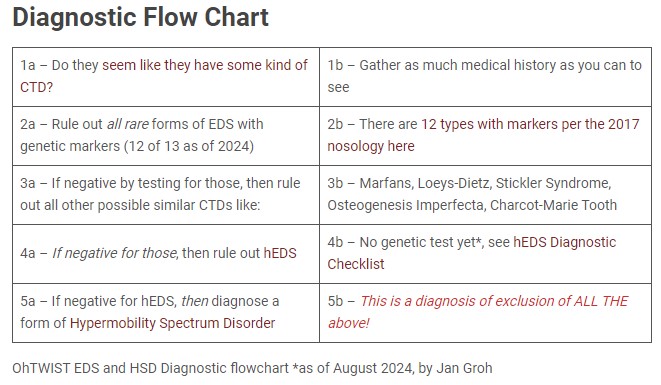But wait, there’s more…
I just hatched a quick and dirty diagnostic flowchart last night that I shared on both social media, and on my Diagnosing EDS and HSD page to help everyone do a better job of ruling out all the things before diagnosing a form of Hypermobility Spectrum Disorders. Which is a diagnosis of exclusion of everything else, to be very clear.
But, I left out a key group of folks, or rather, glossed over them too. That is, people who have all the signs of a rare connective tissue disorder involving any amount of hypermobility and signs of things like EDS, HSD, Marfans, etc.

But… they are negative for any of the currently known rare forms of EDS for which tests are available. And, are negative for any other similar connective tissue diseases like Marfans, Sticklers, Osteogenesis Imperfecta, Loeys-Dietz, etc.
In other words, you HAVE done due diligence, and suspected one or more forms of the above, but testing for same is negative. yet, it’s clear they have more than “just hEDS” (which is still no cakewalk, trust me, but not quite as lethal as some forms) or a form of Hypermobility Spectrum Disorder going on.
For example, things like a torn esophagus, broken back, hernias, and super fragile skin and Riley-Day syndrome on top. Which yes, looks a lot like both classical EDS (cEDS) and even the more rare classical-like EDS (clEDS). Oh, and ROHHAD. (Don’t ask. Pretty sure that group is missing the connective tissue forest for the obese and dysautonomic trees. My friend agrees, as her son has ALL the signs, but they won’t diagnose him.)
But, testing for both is negative, yet, you walk like a clEDS duck, talk like a clEDS duck and… suffer like a clEDS duck. But, you’re negative for the known clEDS variants exactly, for example. Then what?
Then, you try to find a willing and interested geneticist to help you do either WES or WGS and yes, start plowing through those Variants of Unspecified Significance (VUS) that may relate to such things as cEDS and clEDS (closest match), but… whatever else you may find. Using powerful software and smart people to help parse it all. (Not cheap third party sandboxes, no, folks.)
And, as happened to one of my close friends and her son, you may turn out to have your very own syndrome, no kidding. That is, be the first known to have whatever variants you have that make you sick the way you are.
I actually called it years ago, joking that my friend’s son had “Stryder’s Syndrome”, or, something unique to him (and her, it turns out, alas). And sadly I was right. They even ruled out his dad in the matter with testing. He did not contribute to his rare variants. Nope. Just mom. They are the first known to have these particular VUSes. Which look most closely like clEDS.
Another friend has variants – and symptoms and issues including tortuous (“curly”) vasculature – that closely resemble Loeys-Dietz syndrome, even though they did not match the currently known variants for it. They have enough closely related ones that their doctor is operating on the basis that they have a form of as yet uncatalogued Loeys-Dietz. Which is proving wise, as they are indeed suffering in all the same ways folks with LDS do, alas.

So, I think I would add a 3.5a and b above, to read: and, if you have ruled out everything that most closely matches by testing, but the patient really closely resembles someone with a rare form of CTD like clEDS or LDS as mentioned above (for example), then, you will want to document this for science, and treat them like whatever most closely matches. While learning about their specific cases for both their care, and science.
Again, this would be for people who definitely have some unusual rare signs that highly resemble one of the known rare forms of EDS with genetic markers, or similar connective tissue disorders like Marfans, Loeys-Dietz, Sticklers, Osteogenesis Imperfecta etc. But, test negative for all of those yet. So they clearly have something more than hEDS. But they technically don’t match the known SNPs. Yet suffer just like they have a known form of EDS or other CTD.
Science is quickly advancing as shown by this recent study I just learned about today (August 27, 2024) that may enable us to diagnose some (or all) hEDS from skin biopsy and electron microscopy. (May. The science is still being determined.) As you were.

